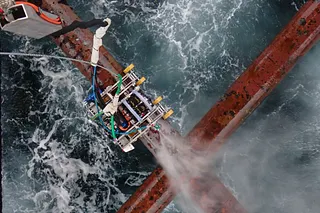Change Language :
Bearing points in inspection robots defy the rough North Sea

The Jacket Crawler is used under water, which means special requirements for the components.
It cleans, inspects and removes the steel structures on the Danish gas platform Tyra: the Robotic Crawler, a robot that makes dangerous and expensive dives superfluous. To protect the robot from corrosion and wear during its work in the harsh North Sea, the engineers rely on high-performance plastics from motion plastic specialist igus®.
The next time you are on holiday in Denmark and turn on the gas cooker, remember: there is a 90 per cent chance that the gas comes from the Danish North Sea. It comes from a platform called Tyra, which has been operated by Total since 1987 and is located 200 kilometres west of the town of Esbjerg. But Tyra is in danger. This is because the porous limestone layers under the seabed are shrinking. The seabed - and therefore the gas platform - has therefore sunk by over five metres in recent decades. This means that the platform is so close to the water that high waves in winter pose a danger to employees. Total has therefore decided to replace the gas platform. Gas production has been suspended until 2022. Construction work is on the programme.
"Thanks to the plastic bushings, we no longer have to worry about corrosion"
Bjarne Lindquist, responsible design engineer at SubC Partner
You can find more interesting applications from a wide range of areas here
Consulting
I look forward to answering your questions
Treotham Automation Pty Ltd. (Distributor)(64) 7849 0281Write e-mail
Shipping and consultation
In person:
Monday to Friday from 7 am - 8 pm.
Saturdays from 8 am- 12 pm.
Online:
24h
WhatsApp-Service:
Montag – Freitag: 8 – 16 Uhr



